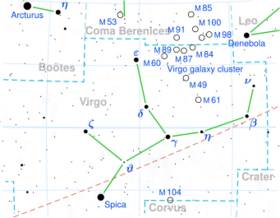Astronomy:Sigma Virginis
From HandWiki
Short description: Star in the constellation Virgo
| Observation data Equinox J2000.0]] (ICRS) | |
|---|---|
| Constellation | Virgo |
| Right ascension | 13h 17m 36.28327s[1] |
| Declination | +05° 28′ 11.5221″[1] |
| Apparent magnitude (V) | 4.86[2] |
| Characteristics | |
| Spectral type | M1 III[3] |
| U−B color index | +1.86[2] |
| B−V color index | +1.62[2] |
| Variable type | suspected[4] |
| Astrometry | |
| Radial velocity (Rv) | −28.26±0.30[5] km/s |
| Proper motion (μ) | RA: −6.06[1] mas/yr Dec.: +9.14[1] mas/yr |
| Parallax (π) | 4.83 ± 0.19[1] mas |
| Distance | 680 ± 30 ly (207 ± 8 pc) |
| Absolute magnitude (MV) | −1.80[6] |
| Details | |
| Radius | 98[7] R☉ |
| Luminosity | 1,610[7] L☉ |
| Surface gravity (log g) | 0.42[7] cgs |
| Temperature | 3,690[7] K |
| Other designations | |
| Database references | |
| SIMBAD | data |
Sigma Virginis (σ Vir, σ Virginis) is a star in the zodiac constellation of Virgo. It can be faintly seen with the naked eye with a baseline apparent visual magnitude of 4.86.[2] Based upon parallax measurements, the distance to this star is roughly 680 light-years.

This is an evolved red giant star with a stellar classification of M1 III.[3] It is a suspected variable star with a brightness that ranges from magnitude +4.77 to +4.86.[4] This variation has pulsation periods of 23.4, 24.3, 27.9 and 34.1 days.[3] The effective temperature of the stellar atmosphere is around 3,800 K, and it shines with 1,734 times the luminosity of the Sun.[7]
References
- ↑ 1.0 1.1 1.2 1.3 1.4 van Leeuwen, F. (November 2007), "Validation of the new Hipparcos reduction", Astronomy and Astrophysics 474 (2): 653–664, doi:10.1051/0004-6361:20078357, Bibcode: 2007A&A...474..653V.
- ↑ 2.0 2.1 2.2 2.3 Mermilliod, J.-C. (1986), "Compilation of Eggen's UBV data, transformed to UBV (unpublished)", Catalogue of Eggen's UBV Data (SIMBAD), Bibcode: 1986EgUBV........0M.
- ↑ 3.0 3.1 3.2 Tabur, V.; Bedding, T. R. (2009), "Long-term photometry and periods for 261 nearby pulsating M giants", Monthly Notices of the Royal Astronomical Society 400 (4): 1945–61, doi:10.1111/j.1365-2966.2009.15588.x, Bibcode: 2009MNRAS.400.1945T.
- ↑ 4.0 4.1 Kukarkin, B. V. et al. (1981), "Nachrichtenblatt der Vereinigung der Sternfreunde e.V. (Catalogue of suspected variable stars)", Nachrichtenblatt der Vereinigung der Sternfreunde (Moscow: Academy of Sciences USSR Shternberg), Bibcode: 1981NVS...C......0K.
- ↑ Famaey, B. et al. (2005), "Local kinematics of K and M giants from CORAVEL/Hipparcos/Tycho-2 data. Revisiting the concept of superclusters", Astronomy and Astrophysics 430: 165–186, doi:10.1051/0004-6361:20041272, Bibcode: 2005A&A...430..165F.
- ↑ Anderson, E.; Francis, Ch. (2012), "XHIP: An extended hipparcos compilation", Astronomy Letters 38 (5): 331, doi:10.1134/S1063773712050015, Bibcode: 2012AstL...38..331A.
- ↑ 7.0 7.1 7.2 7.3 7.4 McDonald, I.; Zijlstra, A. A.; Watson, R. A. (2017), "Fundamental parameters and infrared excesses of Tycho-Gaia stars", Monthly Notices of the Royal Astronomical Society 471 (1): 770, doi:10.1093/mnras/stx1433, Bibcode: 2017MNRAS.471..770M.
- ↑ "sig Vir". SIMBAD. Centre de données astronomiques de Strasbourg. http://simbad.u-strasbg.fr/simbad/sim-basic?Ident=sig+Vir.
- ↑ /ftp/cats/more/HIP/cdroms/cats, Strasbourg astronomical Data Center, https://cdsarc.cds.unistra.fr/viz-bin/ftp-index?/ftp/cats/more/HIP/cdroms/cats, retrieved 15 October 2022.
 |


